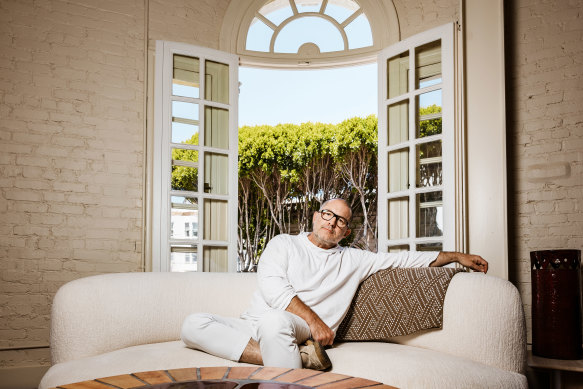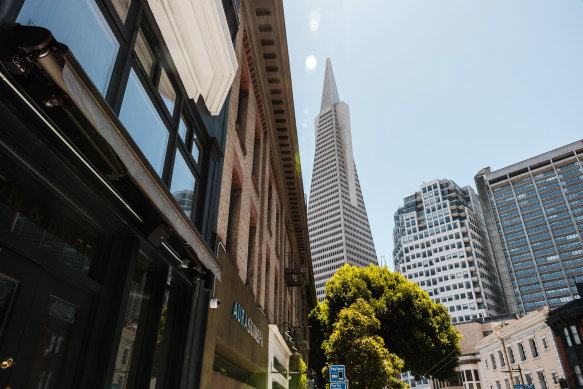This was published 4 months ago
He designed the iPhone before quitting Apple. Now he is building an empire of his own
By Tripp Mickle
Five years to the week after he walked away from the top job designing the iPhone, Jony Ive leaned over a hulking model of a San Francisco city block. The dozen buildings, with each brick carved to scale in Alder wood, had become a prototype for his future.
“We’re standing right now, here,” Ive said, pointing with his black Maison Bonnet reading glasses at a 115-year-old two-story building in Jackson Square, a gold rush-era neighbourhood wedged between San Francisco’s Chinatown and financial district. “We bought this building first, but then we noticed that it had access to this huge volume in the centre.”

Five years after leaving Apple, Jony Ive is forging a new life in San Francisco, one imaginative building at a time.Credit: NYT
The “huge volume” was a parking lot. Each time Ive, Apple’s former head of design, looked at the empty stretch of asphalt, he saw something more: a garden, a pavilion, a place where people could socialise outside as they do at his favourite restaurant in London, the River Cafe. So he bought the building next door. And then he bought another and another. Eventually, he owned half of a city block, including the vacant blacktop.
“This is a very odd thing,” Ive said, looking up from the model on a morning in late June. “For five years, I haven’t talked to anybody about what we’re doing.”
Ive, 57, walked off the world stage in 2019 at the pinnacle of his profession. During his 27 years at Apple, he had conceived the minimalist aesthetic of Apple products. His sleek designs and packaging had influenced everything from the look of televisions to the shape of water bottles. He had become a rare industrial designer turned celebrity who was a co-chair of the Met Gala and helped J.J. Abrams, the director of Star Wars: The Force Awakens, dream up a new lightsaber.
But after leaving Apple to start his own design firm, which he named LoveFrom, Ive largely disappeared. The firm’s website displayed only its name in a self-made serif font. Its sparseness led people across Silicon Valley to joke that Ive had spent five years designing a typeface. But behind the laughter was the same curiosity: What was Ive up to?
Ive’s city block model offered part of the answer. Over the past four years, the British designer, whose wealth is estimated in the hundreds of millions of dollars, has quietly accumulated nearly $US90 million ($131.6 million) worth of real estate on a single city block. The purchases began early in the pandemic, at a time when many tech luminaries were fleeing San Francisco. Ive found the exodus noxious.
“I owe the city so much,” said Ive, who moved to San Francisco in the 1990s. “The area had attracted so many people because of its talent, but as soon as things stopped working out, people were leaving.”
Dressed in a white, long-sleeve, hooded T-shirt, stone chinos and Clarks Wallabee shoes, Ive said he wanted to draw creative types to the edge of downtown. He has been turning one of his buildings into a home base for his agency’s work on automotive, fashion and travel products. Another is the headquarters of a new artificial intelligence device company that he is developing with OpenAI.
“I don’t know whether it was reckless,” he said of his building acquisitions. “It certainly wasn’t arrogant. It was well intended. But I really felt we could have a contribution.”
Tech executives spending their fortunes on real estate or more imaginative adventures is a staple of Silicon Valley culture. Some buy islands, others build yachts longer than a football field or fund quixotic flying car projects. Ive’s fixation on a single city block, by comparison, seems modest.
But for Ive, Jackson Square also represents personal reinvention. Few people walk away from their profession’s premier job. Even fewer start over again. A self-professed control freak, Ive decided that he had fretted enough over the snugness of each iPhone box, the layout of every Apple Watch component and the curve of every iPad corner. He wanted something new.
At LoveFrom, he has tried to trust his instincts. Buying one building led to buying another. A discussion about a new yarn led to his first fashion apparel. Work with one client, Brian Chesky, the CEO of Airbnb, led to meeting Sam Altman, the CEO of OpenAI.
It is unclear what the real estate spending spree will amount to, and for all of Ive’s success, there have been points when his design instincts and expensive tastes went too far. He has been criticised for putting form over function. Some MacBooks were so thin that the keyboards malfunctioned. Some of Apple’s biggest fans mocked the custom gold watch that the company sold for $US17,000.
‘You somehow have to make friends with uncertainty.’
Apple’s former top designer Jony Ive
But over two days with him earlier in the summer, it became apparent that he has become more relaxed, even as the range of projects he tackles explodes.
“What I’m learning is to trust, more than ever, my intuition,” Ive said. “That’s the thing that I’m most excited about.”
When Ive first considered leaving Apple, he turned to his friend Marc Newson for advice. The Australian-born industrial designer, who joined Apple in 2014 to work on the Apple Watch, had spent his career at an independent design firm with work that ranged from luxury yachts and surfboards to Louis Vuitton luggage and vibrators. Newson suggested that they start a creative collective to work on projects.
Recalling those early conversations, Newson said the goal was to leave behind the grind and rigor of Apple. “The freedom was the idea,” Newson said.
Over five years, Ive and Newson hired architects, graphic designers, writers and a cinematic special effects developer who work across three areas: work for the love of it, which they do without pay; work for clients, which includes Airbnb and Ferrari; and work for themselves, which includes the building renovation.

Ive is snapping up properties all over San Francisco.Credit: NYT
He and Newson hope the renovation, which is scheduled for completion in late 2025, draws others to the area. Several firms have already followed, including Emerson Collective, which was founded by Laurene Powell Jobs, and Thrive Capital, the venture capital firm with ties to OpenAI.
“There’s a counterintuitive opportunity to prove people wrong” about San Francisco, Newson said.
Though Ive is optimistic about their work and enthusiastic that it could make his investments in Jackson Square worthwhile, he is uneasy about the future. It is only natural for him to be afraid that he spent too much money on property or worry that his startup could fail.
But seated on a plush cream couch near LoveFrom’s model of Jackson Square, he said that his philosophy was not to let success be determined by a number. Judging a real estate purchase or a new device by its return on investment would miss the point. Life’s most important decisions require leaps into the unknown.
“You somehow have to make friends with uncertainty,” he said. It was a very un-Apple-like view of the world.
This article originally appeared in The New York Times.
The Business Briefing newsletter delivers major stories, exclusive coverage and expert opinion. Sign up to get it every weekday morning.